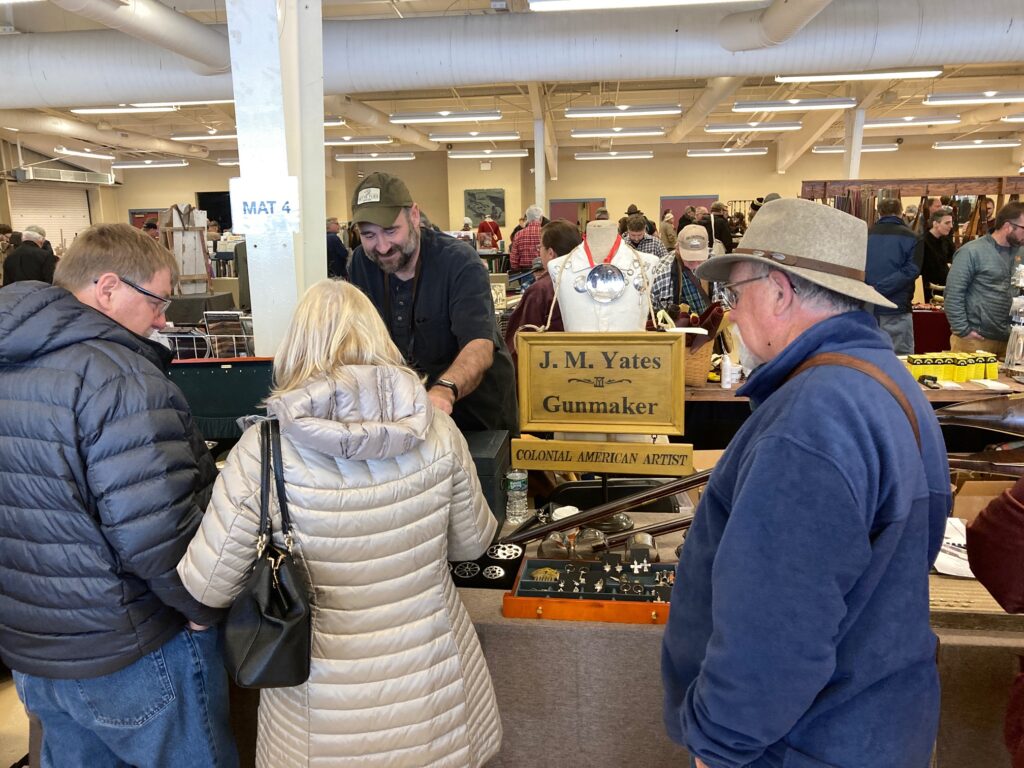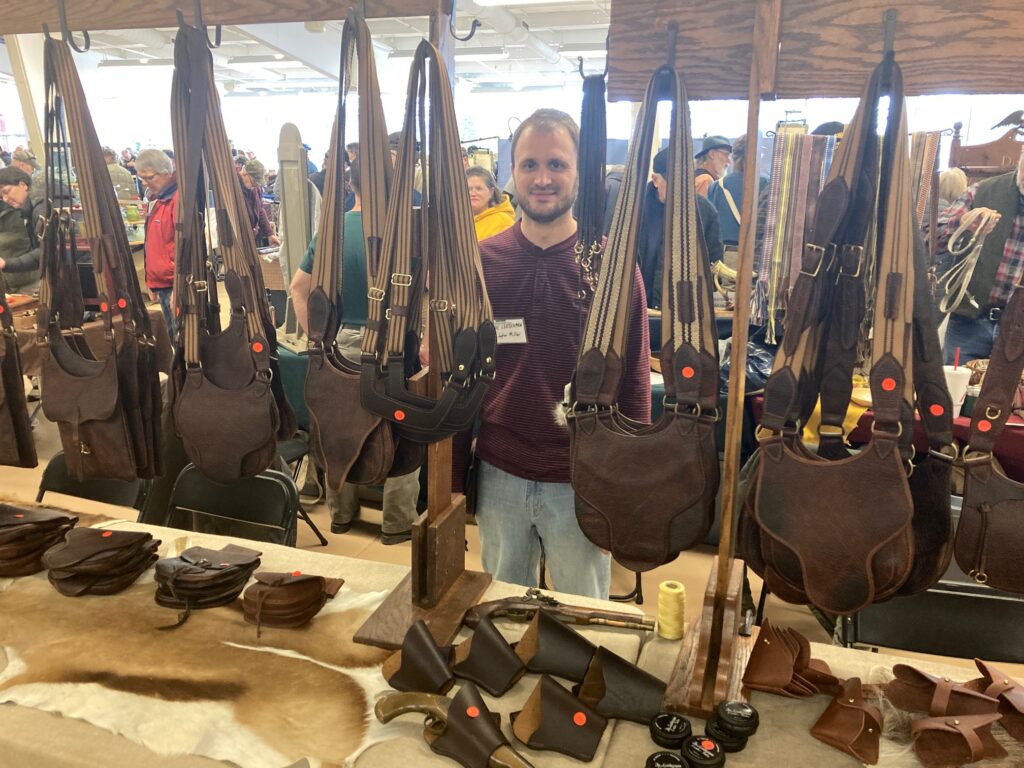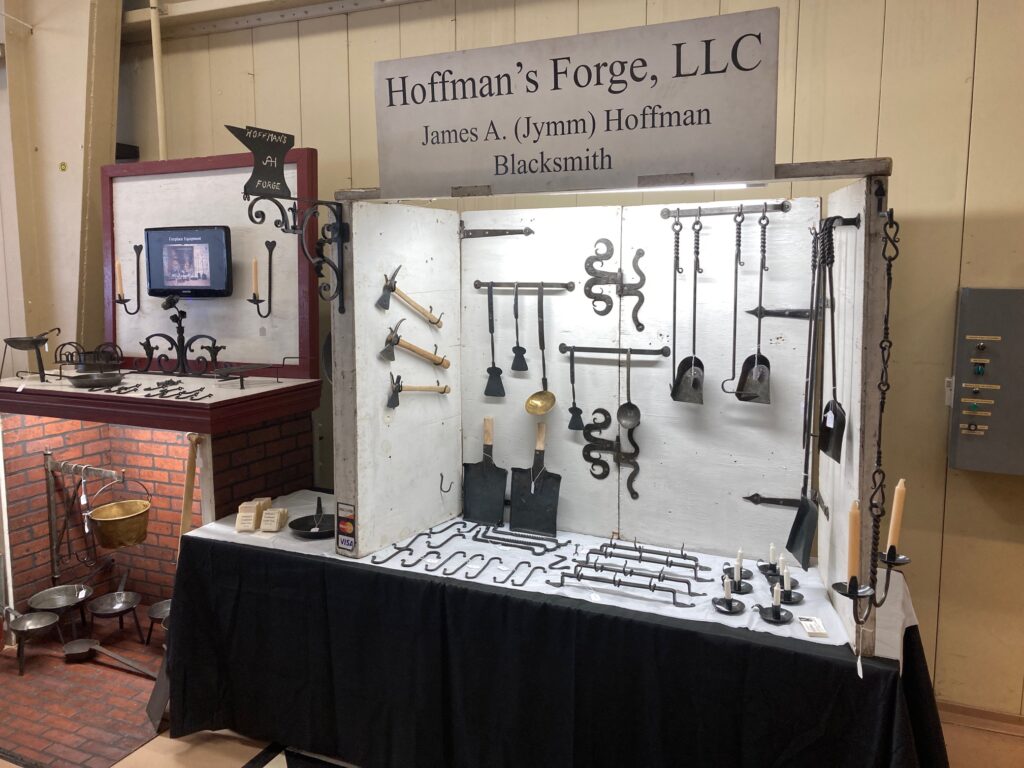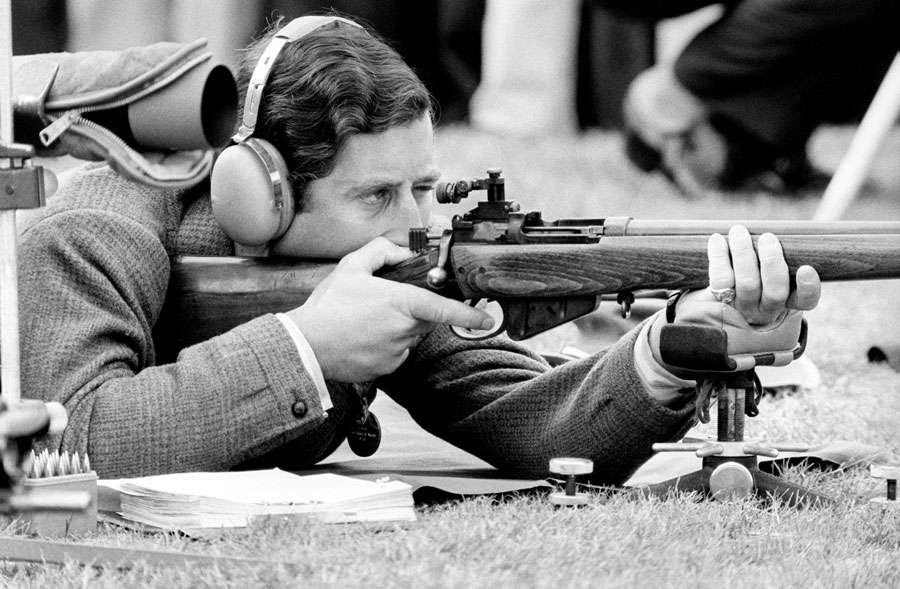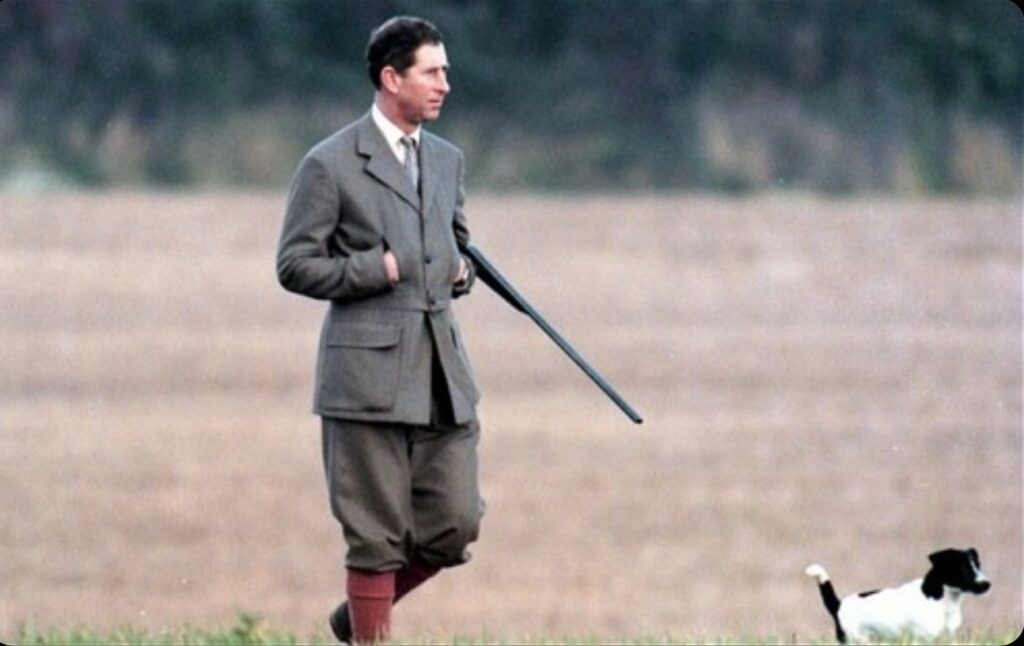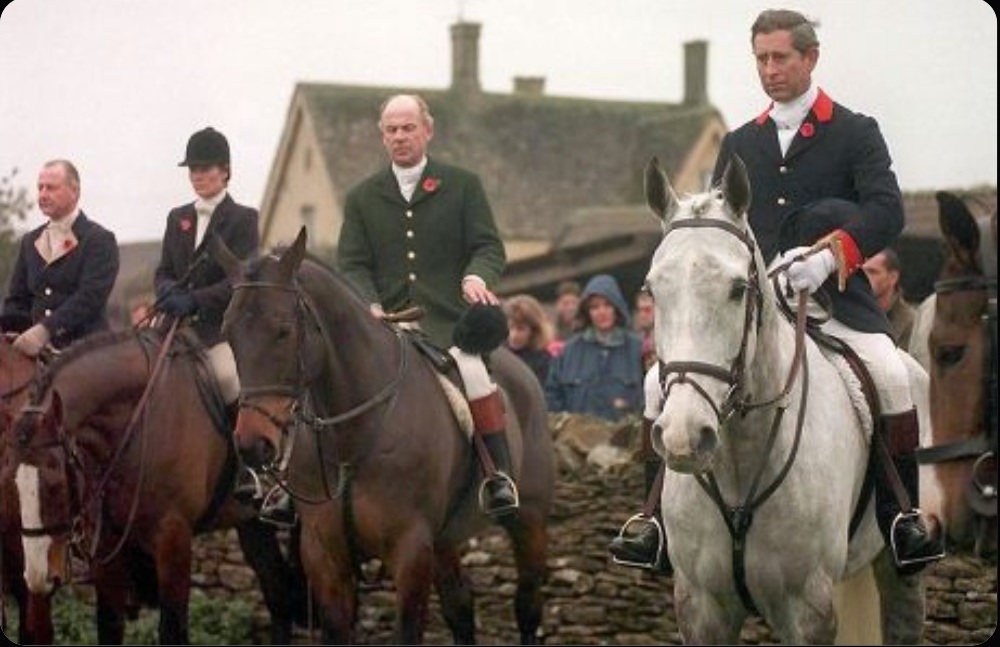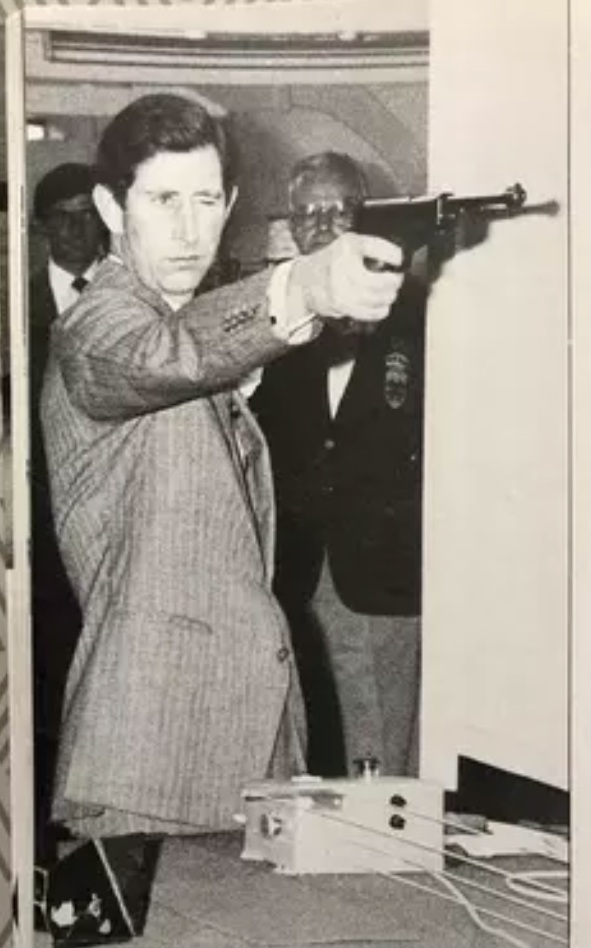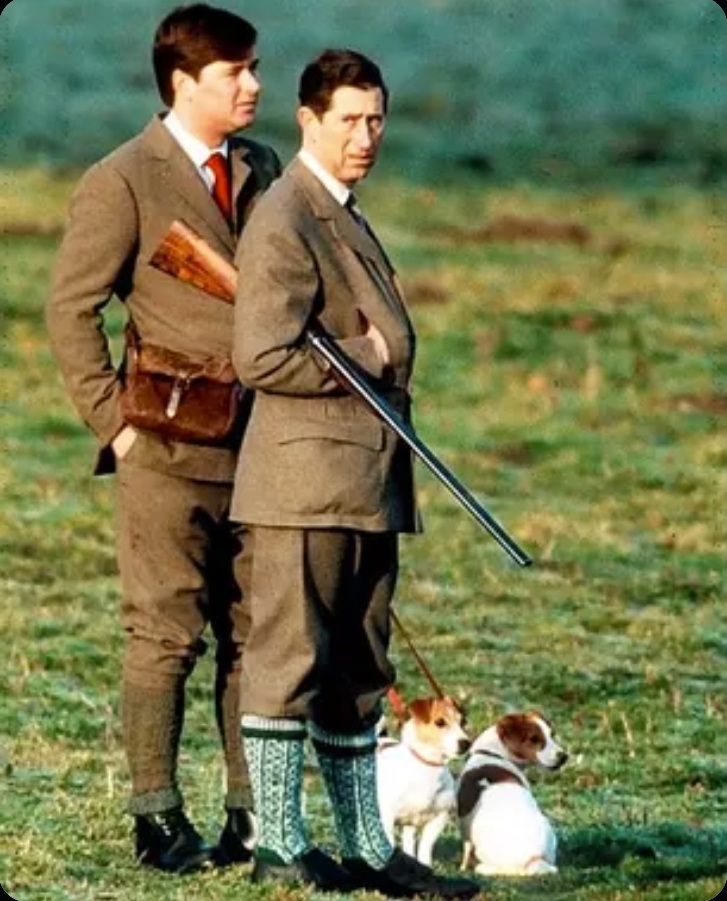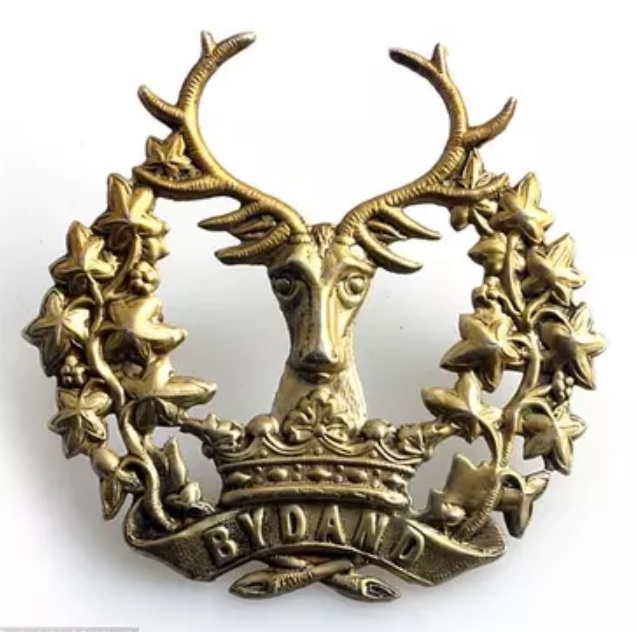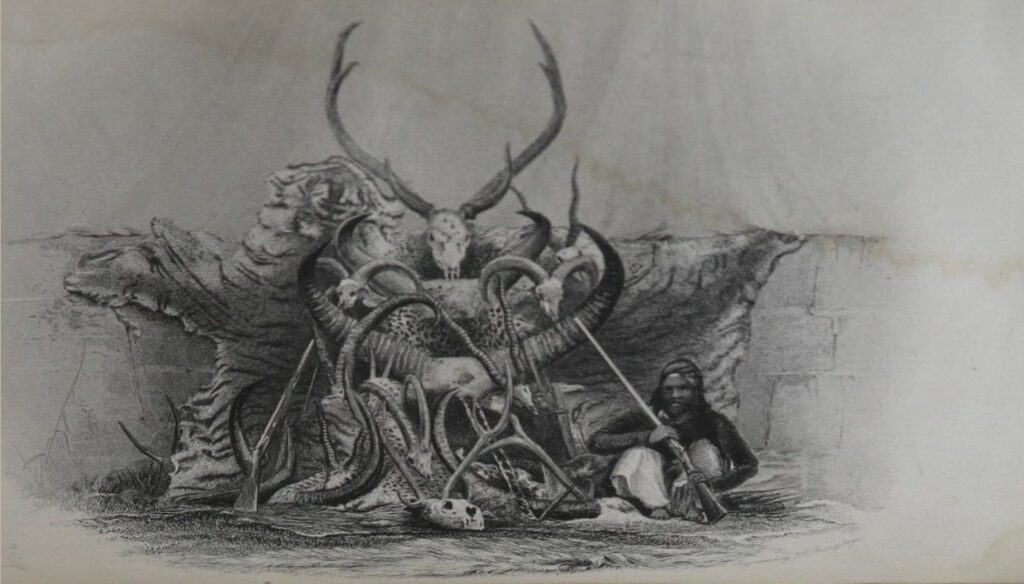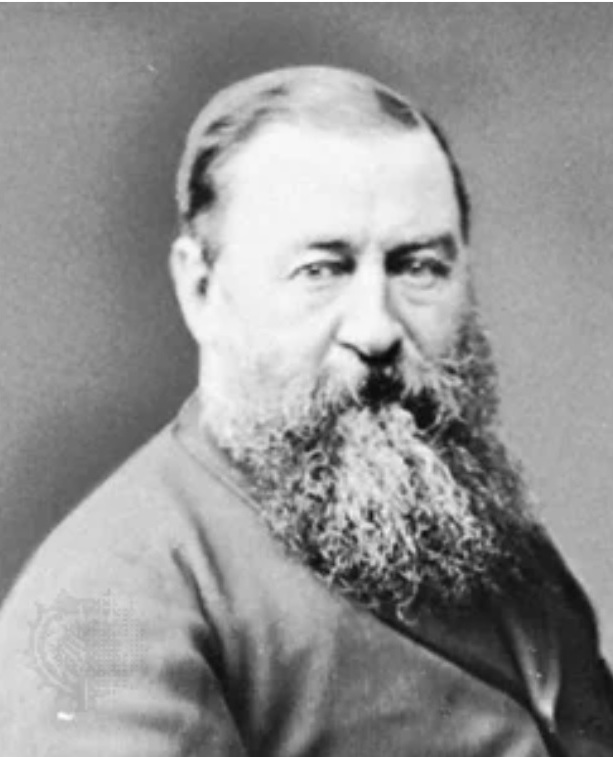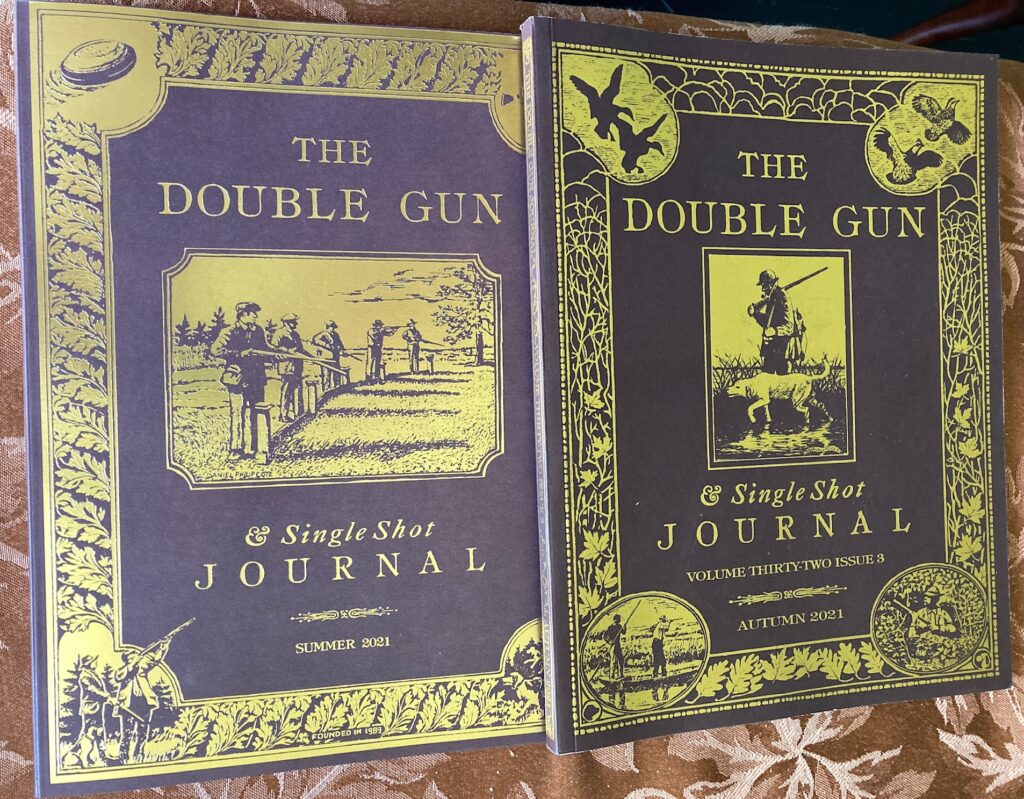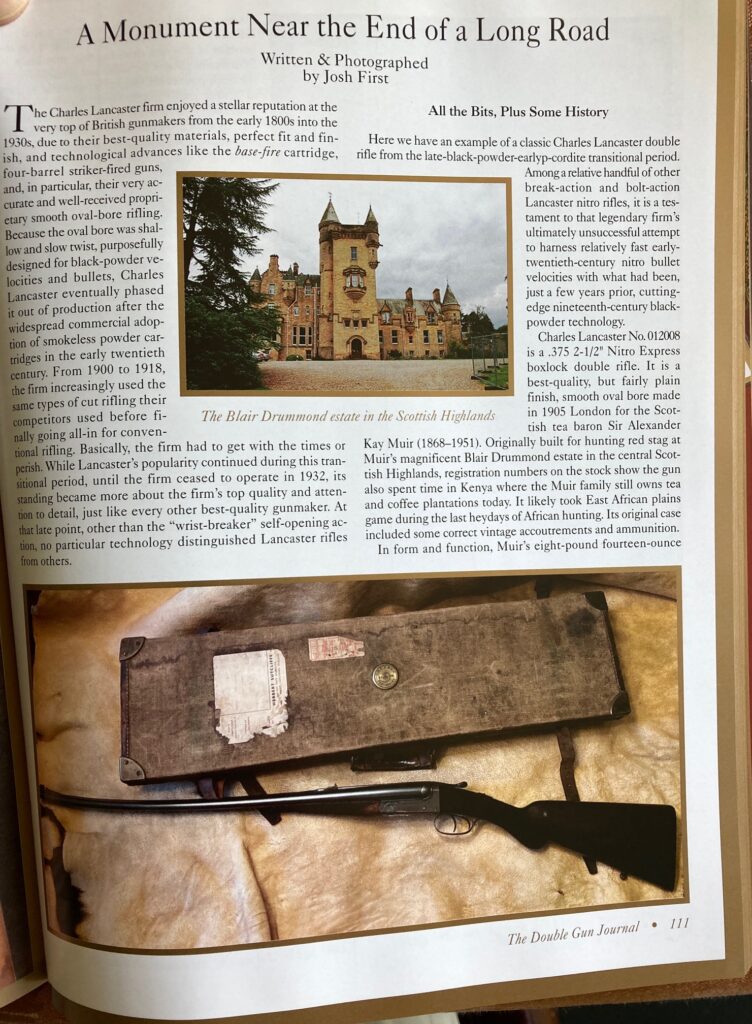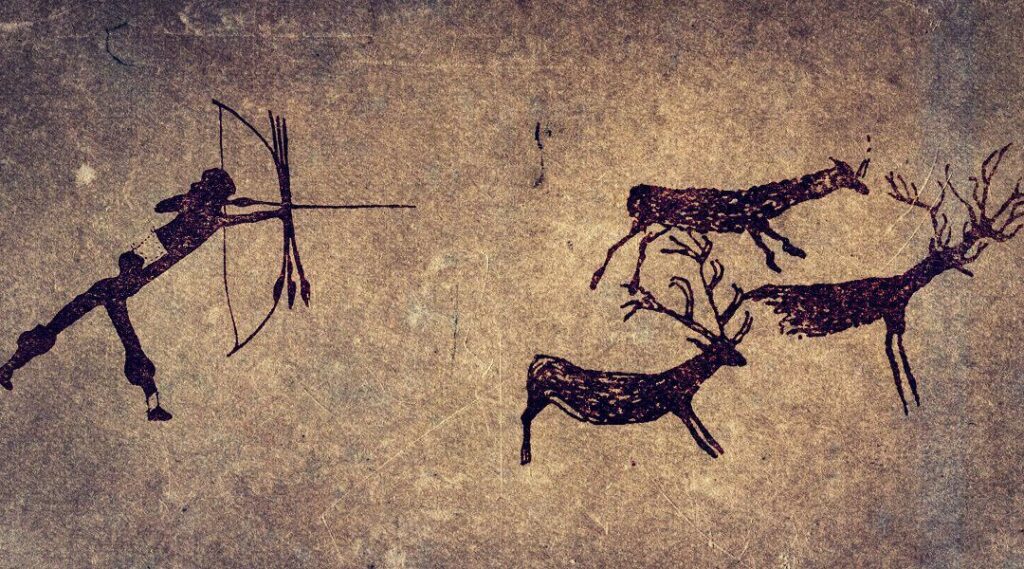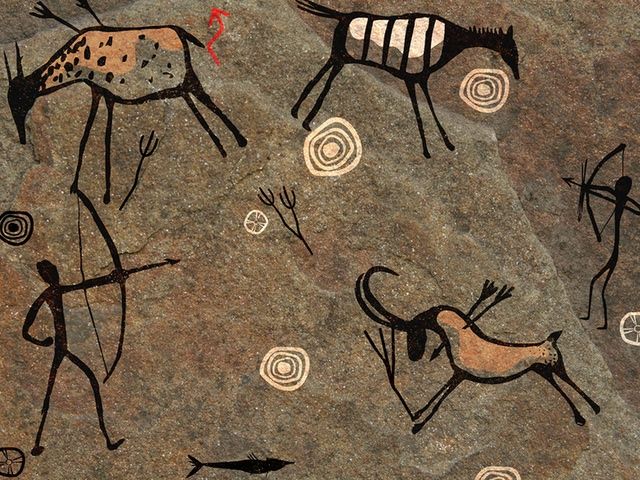Posts Tagged → rifle
Two great shows coming up soon!
Two great shows are coming up soon. If you live in central Pennsylvania, then fortunate you. If you live farther out or even far away, even out of state, both are worth traveling to, even from far, far away.
The first show starts this Friday, the 18th Century Artisan’s Faire, now (as of last year) held in Carlisle, PA, at the Carlisle Expo Center at 100 K Street. It used to be called the Lewisburg Show, because for decades it was held in Lewisburg, PA, along Route 15. The Carlisle Expo Center is SO MUCH BETTER than the prior hotel venue. I went to this show last year and could have easily spent both days there. Better lay-out, better room, more room, higher ceilings and far better lighting.
If you are afflicted with history-itis, with a passion for hand-made tools and utensils of all sorts, including eating utensils like forks and knives and plates, with blacksmithing and historic reenacting, with hand-carved curly maple furniture and gunstocks, leatherworking, with anything black powder or flintlock or percussion, with 17th and 18th century clothing, then this show is for you. I have been attending for I don’t know how many years, a long time, and every time I go it’s worth it. The nationwide talent that is assembled at this show is amazing to experience.
The second show starts this Saturday, the Great American Outdoor Show. It is held for the whole week in Harrisburg at the Farm Show Complex on Cameron Street. This is the “new” show built on the ashes of the old one, which I helped end by starting a boycott.
The prior show was run by a British promoter, and they had no feel for America, Americans, guns, gun rights etc. In the immediate political backwash of another Democrat-run mass school shooting, that British promoter tried to prohibit exhibitors from having AR-15 platform rifles. That set off a slight negative reaction among the paid participants, advertisers, and attendees that culminated in the boycott, which ended the show that year. And it ended that tone deaf promoter’s role in the show ever-after.
In the press interviews I did about shutting down that show, my favorite quote was “The British did not understand Americans in 1776, and they still don’t understand us in 2012.”
To which I think we can easily now add the entire Democrat Party, because it is openly and officially the political party of big government, of citizen disarmament and gun confiscation, of digital currency and your money control, of high taxes, of speech control, of thought control, of censorship, of car control, of health care control, of Covid lockdowns and private citizen movement control, but not USA border control.
Nope, under the Democrat Party the American border is wide freakin’ open to tens of millions of anyone and everyone from around the world.
So, go to these two shows. Both are very family friendly, regardless of what your family members each like. You will be really happy you did go. Enjoy America and freedom while you still can.
On Friday and Saturday you can rub elbows with gunpowder horn makers, flint knappers, flintlock and percussion rifle makers, black powder bag makers, historic dress and bonnet makers, tri-corner hat makers, and blacksmiths.
On Sunday you can go to the Farm Show Complex and see the whole world of tactical socks and vests, endless semiauto blast-em rifles as well as very cool historic lever action rifles and Wild West revolvers, bushcraft duck calls, high fence deer hunting legends and other TV created one-dimensional personalities, useful ATVs, fabulous boats, and cool end-of-the-world survival RVs, high tech synthetic and high tech wool outdoor boots and clothing, hunting guides from all around the world, and all kinds of fishing stuff. The Great American Outdoor Show really is an amazing experience. I highly recommend it.
I myself will be both a visitor and a volunteer at the GAOS. After many years of volunteering at the show and its predecessor, I took 2021-2023 off. This year I will be volunteering one or two days with the Pennsylvania Trappers Association, a wonderful conservation group of which I am a Life Member. Come on by the PTA booth and chat with us!
Do deer processors give you back your own deer?
Pennsylvania rifle season for deer is nearing the end of its second and concluding week. On average, Pennsylvania hunters annually kill 400,000-500,000 deer, and I would just hazard a guess that 2/3 of those carcasses are taken by the hunter to local deer processors.
Tonight, deer processors across Pennsylvania are working triple-staffed and double overtime to process the hundreds of thousands of deer being brought in by successful hunters.
A perennial question asked by both new hunters and well seasoned is “When I pick up my deer from the processor, will it actually be my deer I am getting, or will it be someone else’s deer?”
There are two certain answers to this question, and I base these on my own experience and the experiences of many friends and acquaintances.
First answer, Maybe. Depending on what you want done to your deer, you might get back 100% of your deer or you might get back 75% of your deer, with the 25% difference being parts of other people’s deer. If you just want real simple cuts, basic steaks from the backstraps and the hams, and roasts from the neck, leg, and shoulders, then you stand a better chance of getting your deer back. This is because it is almost as easy for the processor to cut your deer up into these basic cuts with a bandsaw and a boning knife as it is to grab whatever oddball cuts he has on hand to fill your order.
Second answer, when ordering sausage and hamburger, is absolutely No. This is because deer sausage, pepper sticks etc. are made from various trimmings and random pieces of deer as they are brought in from the very beginning of the archery season, based on the kind of demand that processor has experienced in the past. Additional batches of sausage are made as demand increases towards the end of archery season and into the rifle season. There is just no way that your deer can be turned into its own sausage mix. Your deer might be contributed to a big pot of deer trimmings destined for sausage, and you might be getting your portion of that sausage, but that sausage just isn’t going to be yours and yours alone. It will be a mix of various deer brought in the same time as your own.
I cannot tell you how many times I have gone through the expense of having my prize deer turned into beautiful shrink wrapped cuts at a processor, only to discover that the cardboard box I received my order in is short at least ten to fifteen pounds of venison (from a huge buck). And worse, some random pieces have been thrown in a try to make the balance, as the processor guesses it. And some of the packages have been frozen a long time. And the same cuts of meat are colored differently, as though from different animals.
The truth is that if you want to eat your deer, then you must either butcher your deer yourself, or get together with buddies and butcher all of your deer together.
Butchering a deer by yourself is much easier than most people think, especially if you are willing to cut up the backstrap and hams into basic steaks, and then grind up everything else for hamburger or sausage. In fact, I am about to take a deer I shot today over to a friend’s house where we are going to butcher it in his garage. This is going to be his first experience doing this, but I am sure it will not be his last time.
With buddies, you can pool your odd trimmings and leg meat for sausage. One or two guys or their wives run the sausage/ hamburger grinder and filler, and by the end of the weekend the sausage has been cooked/smoked, and everything is all done simultaneously. I have seen a historic hunting camp in Elk County that had the most impressive kitchen and butchery set-up, including scales for weighing both the whole deer and the various parts and cuts. This is nice so that the guy who shoots a 60-pound yearling gets his deer, and doesn’t unfairly get a bonus pay-out taken out of someone else’s 120 pound deer. Unless this is the way everyone agrees to work together: Everyone goes home with more or less the same amount.
Nothing against the deer processors, they have an important role to play. But the question asked in the beginning can only be satisfactorily answered by doing the job yourself, and I can say from long experience that butchering a deer is easy and gets faster and easier the more experienced at it you become.
Yeah, PA’s lame bear season in one picture
Pennsylvania is about to have one of its lowest bear harvests in decades. And like so many policies of any sort, the story of this failure is told not just by the data, but by a picture of the data (see below).
In sum, this year’s early bear seasons of archery and muzzleloader resulted in roughly 1200 bears being taken by hunters. These are predominantly individual hunters in elevated stands, not crews of drivers pushing bears to standers.
By the time the real firearms “bear season” arrives in late November, much of the steam has been bled out of the system, so to speak. The demand has been met. Many serious bear hunters have already taken their bear and they won’t be going “to camp” to participate in punishing bear drives through thick mountain laurel on steep mountains in the northcentral region. And when the most ardent hunters pull out of a camp, that loss of energy and excitement affects everyone else. We noticed many empty camps across the entire northern tier this past week.
Again, the 1,217 bears taken in the early season so far are 200 bears ahead of the roughly 1,000 bears on record for the “bear season” as of tonight, which is the end of the formal “bear season.” In other words, bear season wasn’t. It is actually producing behind the early season.
So is the early season the real bear season now?
Add a poor acorn crop to the situation, and whatever bears were roaming around in October’s early season have gone to den for the winter now in our “bear season,” or have moved southward by the time November arrives, because all of the available wild food has been eaten up. We are now in our third year of a failed acorn crop in the northern tier, and the silence of our woods shows it. No food means no wildlife. Hunters saw no poop, no deer rubs, no squirrels, no nothing. Hunters scouring rugged northern tier landscapes that are the historic high producers of bears are encountering woods devoid not just of bears, but of deer and turkey, as well.
Yesterday was a classic example of this dynamic. Our guys put on a drive across a NW Lycoming County mountaintop area that usually holds bears. I was the lone stander in the primo spot, a saddle between two hills with a stream running through. I could see far in every direction. There were no other drives happening anywhere around our guys, which is unusual. But another and much larger drive was going on behind me, and pushing toward the area we had hunted the day before. And half a mile down the forest road several long range hunters were set up looking across a canyon. If there were bears around, or even deer, the two drives would push them past the long range guys, at least.
And yet, by the time dusk arrived and our men had slid and tumbled down the mountain side to gather at the truck, no one anywhere had seen a bear or a deer, nor heard a shot. The long range guys were packing up as we were driving out, and they told us they had seen several deer on Sunday, but nothing else any other day, including that day that had so much activity.
The Pennsylvania Game Commission is a government agency, and agencies make mistakes. Sometimes the best-intended and carefully considered policies have unintended consequences. Maybe the Saturday opener (as opposed to the long-time Monday opener) to bear season is part of the failure we are seeing. Maybe it’s the acorn crop failure making a bad situation worse. Maybe it’s the early season stealing all of the thunder from the regular rifle bear season. I don’t know the entire answer why, but the numbers don’t lie, and this 2023 bear season was a flop. Yes, we will see another 100-200 bears taken in the extended season that is concurrent with deer season in some Wildlife Management Units. But overall, PA has not seen a bear harvest this low in a long time. And as I recall, last year wasn’t that great, either.
Something is wrong and something needs to change. A lot of small businesses in rural areas depend on these big bear and deer seasons to make their end-of-year financial goals. Let’s hope the PGC staff and the board are up to the task of fixing it.
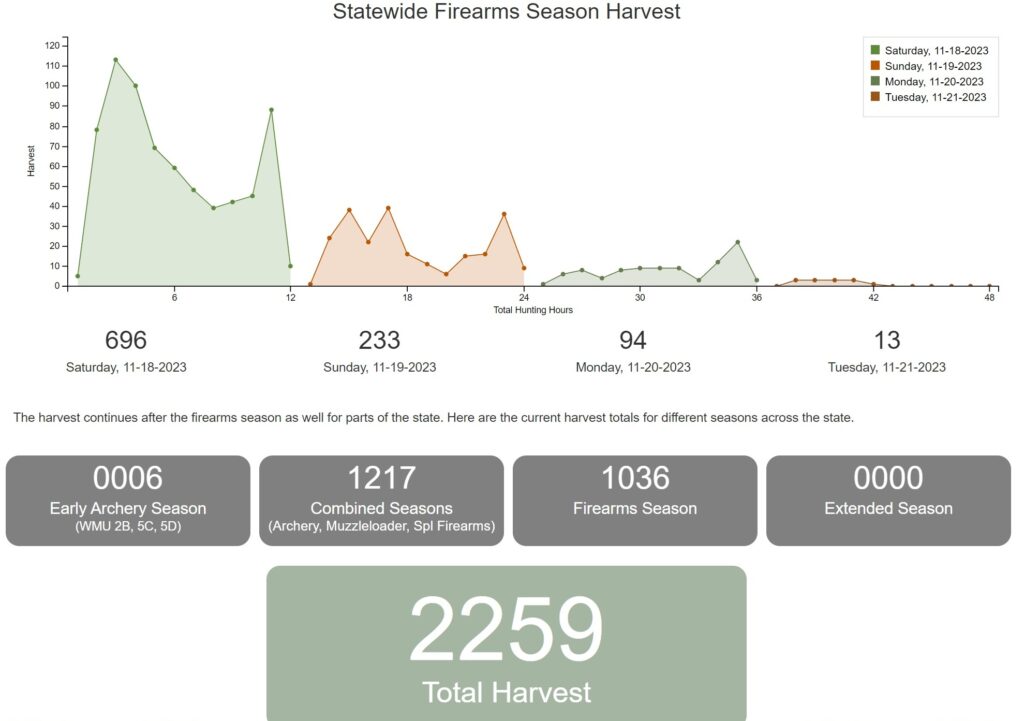
Harvest results as of the last night of regular rifle bear season, 2023. Not final, but not going to change much. The early season was the best season.
A few more thoughts on Alaska gear & public land
Even people who will never hunt in Alaska want to know what kind of gear a guy carried while he was there, and they might even have some opinions about it. Alaska is kind of the go-to place for all imaginary hunts, survivalist prepping, and bush homesteading, and you can go on YouTube and on any related video find endless debate about guns and gear by all kinds of people, 99% of whom have never been to Alaska. After the “Thousand Overnight Tragedies” essay here a week ago, I got some questions about my hunting kit from people who will never do anything more than a luxury cruise to Alaska. I know well that if a couple guys ask, there are more who want to know but didn’t ask. So here goes, my best advice on how to be properly kitted out for Alaska.
First off, before assembling your Alaska kit you have to determine if you are staying out in the Alaskan wilderness. Plenty of people get air dropped into a remote wilderness spot, tent up near the lake or river where the float plane landed to drop them off, and that’s their base camp they hunt out of every day. It is the same place the plane will pick them up from in a week or ten days. If this scenario is how you are heading into Alaska to hunt or fish, then you need all of the survival gear, various fire starting methods, a beacon, etc. kit that you would need while wilderness hunting anywhere else in North America. My Seek Outside tipi tent with the large titanium wood stove has made all of the difference for how I hunt in wilderness (thanks to Ranger Ian for his guidance on this years ago after I reported how I nearly froze to death in his service territory).
Second, the month of year really makes a difference in Alaska. I have been there in July, August, and September. July and August are usually quite comfortable. In September you are beginning to get some chilly nights, and possibly chilly mornings. Maybe a chilly day. Warm clothing you can easily layer on and off, like a Filson wool vest, becomes critical the later it gets after August ends.
Finally, where exactly in Alaska are you going? Central Alaska encompasses most of the state, and it is kind of the rugged classic interior Alaska everyone thinks of when they imagine Alaska. But all of the state’s coastal areas are really different from the interior, especially as you begin to head north or south of Anchorage. Southeastern panhandle Alaska is a temperate rain forest. It rains there even when it is not really technically raining. Something like fifteen to twenty FEET of rain falls there in the southeast. Obviously you have to be prepared for regular rain if you are hunting and fishing in the panhandle.
If you are hunting out of an Alaskan home, say your friend’s or your cousin’s, or from a lodge, and then driving or boating to your destination each day, with plans of returning before dark, then here is the kind of checklist you will appreciate:
- Rubber rain suit, jacket with hood and pants. My 25-year-old Cabela’s blue rubber rain suit worked fine for both repelling the constant light patter and sometimes more steady rain. It also served as my wind breaker with only a tee shirt underneath. Blue is a bad choice for hunting, because many animals see blue like humans see fluorescent orange. When my blue rain suit finally dies, I will get a green one.
- Good rubber boots and also good leather hunting boots. I used both, sometimes on the same day, the rubber ones in the morning and the leather ones later in the day, or vice versa. If you are hunting hard, you need rigid ankle support, and I have not found a better boot for hunting in steep, rugged terrain than the Danner Canadians. I especially relied on the Danners on the SE AK island we hunted for blacktail deer. For this recent trip I finally bought my first “good” pair of rubber boots, the only “hunting style” rubber boots that properly fitted my enormous duck feet, by Irish Setter. These worked great in all wet environments I encountered, many of which were the margins and shallows of salmon streams. A PEET boot dryer is a good thing to have waiting at home at the end of the day.
- A light day-use backpack holding extra clothing, extra ammo, food, water, GPS (I use a Garmin 62s with detailed mini SD card maps) a range finder, binoculars, etc is an absolute necessity. My LL Bean hunting pack has accompanied me on hunting trips from the Scottish Highlands to Alaska and a lot of places in between. It is a fabulous and extremely durable, well thought out piece of kit.
- Binoculars are essential in Alaska, because it is such big country. Doesn’t matter if you are hunting or fishing, you absolutely must be able to see what is happening around you, if for no other reason than Alaska serves up cantankerous grizzly/ brown bears by the minute almost everywhere you go. And occasionally mean moose. Plus binoculars help you see game you are after, or maybe circling marine birds distantly picking off scraps as larger fish feed at the surface, where you can easily catch them. Leupold has been my USA-made go-to binocular maker for a very long time, after using various Nikons for a while. Yes, you can’t go wrong with Swarovskis or Zeiss, but I am brutal on my gear, and I will cry like a baby if all 265 pounds of me face plants on top of the $3,000 binos strapped to my chest. So I use a pair that are almost as good as the $3,000 pair, but which cost about 800% less.
- Range finder. Any modern range finder is useful for hunting in big country like Alaska, except over water. If you are hunting directly over a large body of water, then you need to calibrate your piece, or it will give you whacky results. I use a Nikon Forestry Pro because I work in the forest products and land business, but it has also served me just as well in hunting. I have learned that this model is rugged, because I use mine so much, in so many tough environments.
- Knife. Yes, you need a strong, sharp knife to go hunting correctly. I won’t wade into the whole which steel is better than my grandma’s Old Hickory no-snob high carbon potato peeler knife. And if anyone ever says the word “bushcraft” within arm’s length of me, you’re gonna get a healthy serving of country whoop ass. Because I can’t take it any more. The whole “bushcraft” genre is such urban flatlander weekend warrior nonsense, for God’s sake, let it be, leave it alone, leave it behind. A hunting knife can be almost any shape, size, and steel type that has worked well for you in the past. The Inuit and Inupiat just south and north of the Arctic Circle use Old Timer pocket knives, grandma’s ulu made of whale penis and wrought iron, and occasionally a high quality modern “huntin‘ knife” left behind by an appreciative tourist hunter. And guess what…all of these various shape knives work just fine for the subsistence lifestyle a lot of Inuit and Inupiat live. And they kill, skin, dissect, and eat raw on the spot – with their varied assortment of knives – more critters in one month than you will kill in a lifetime of Lower 48 recreational huntin‘. I happen to use various JRJ knives made by John R Johnson of Perry County, PA, because his ATS-34 steel and overall craftsmanship were as good as any huntin‘ knife available anywhere on the planet. Unfortunately, John has not made a knife in almost ten years. Fortunately, for years I bought armloads of knives that he custom made for me, and I enjoy using every one of them every season.
- Rifle. Yeah, some guys hunt Bigfoot with a souped up .44 Magnum or 454 Casull handgun. So what. A rifle is light years better than a handgun in every way, and I hunt big game only with a rifle, especially in real big country like Alaska. On this recent trip I carried my friend’s Henry 45-70 lever action, loaded with the Federal Premium HammerDown 300 grain rounds. There are hotter, more effective 45-70 rounds available from CorBon and Grizzly, but I was happy with the 3″ 100-yard performance of this round out of my friend’s rifle. And I don’t know how up to snuff the Henry is with the hotter 45-70 loads. The problem with the Alaska panhandle is that the weather there absolutely eats guns. If the saltwater doesn’t kill your gun, the constant rain and moisture will finish the job. A stainless steel gun like the Marlin 45-70 SBL is probably the best possible hunting rifle for Alaska. And this gun can handle the hottest 45-70 loads. One comment about the Henry: Its rear sight was very frail and kind of sad. It moved around all by itself, which can result in a severe mauling or death by Griz, if you happen to not check up on the rear sight and adjust it as needed every ten minutes.
- Backup pistol and bear spray. Bear spray works very well in places without wind or breezes. If you use bear spray in a place with wind or strong breezes, you are likely to incapacitate yourself instead of the bear (insert stupid human hungry bear joke here). I happened to be hunting and fishing in a SE AK place with constant winds and breezes, so I dispensed with the bear spray and kept a .44 Magnum revolver on my hip, loaded with some bear-buster ammo and not the ubiquitous 240 grain JHP that is guaranteed to piss off Griz more than kill him. Speaking of backup, I carried an emergency beacon of unknown make or vintage on most of my hunts.
- Clothing. My old tried-and-true Cabela’s Gore-Tex hunting pants were perfect for the cooler days, and my old tried-and-true Columbia nylon zip-off cargo pants were perfect for the warmer days. A wool hunting shirt in red and black buffalo plaid (of course) with some thermal long underwear is all I needed in the early season. I wore a no-name fluorescent orange fleece hat as well as my 2020 Trump hat. Sometimes together when it was cold. Mid to late September and beyond, you need real cold weather gear.
Good luck if you go DIY hunting in Alaska. DIY solo is my thing, and I think it is the most fun way to wilderness hunt. The challenge with DIY in Alaska is it is so big, and the critters are so big, and the distances are so big, and the civilization is so small and so far away. You really can’t do a DIY hunt by yourself in Alaska. It is not safe, and a thousand things can go wrong after you are successful and kill the animal of your trophy dreams. Go with a friend, go with a guide. And be smart about balancing your kit with practical items you are truly likely to need. Hunting in Alaska is not automatically a survival test or a Bataan Death March. You don’t go to Alaska and automatically plunk yourself down in the woods and start doing a video on (puke) bushcraft. It isn’t all dangerous, nor is Alaska all wilderness. Plenty of good hunting and fishing is available a decently brief drive out of any of the major cities, but it does get better the farther out you go.
Speaking of going further out of civilization, all this amazing hunting and fishing and trapping in Alaska is possible only because of the huge critical mass of public land there. Yes, I agree that federal and state agencies sometimes mis-manage public land. And sometimes those agencies end up “mis-managing” their relationships with the American citizen taxpayers who pay the agency staff and who own the public land the agencies are supposed to steward. But I think that public land is one of the very few things that government does pretty well. And even when government staff screw it up, the public land is still there afterwards.
The king you got, not the king you wanted or needed?
Two days ago was Coronation Day in England, whereupon the former very very longtime Charles Prince of Wales became Charles King of England AKA King Charles III. Even in The Year of Our Blessed Freedom From Monarchy 2023, this is still a big deal, because like it or not, kings and queens can matter when they want to, for better or worse.
This new king follows on the heels of his most amazing and impactful mother Queen Elizabeth, whose traditional values and top notch leadership skills many people miss. It appears Charles also wants to matter, like his mother, to be of consequence, to make what he believes is a positive difference on Planet Earth. So, we take note of his ascendence. He may not be the high caliber of his mother, who many would have liked to have seen replaced by another woman or man of equal qualities (good luck finding such a person anywhere in Western Civilization today), but Charles is nonetheless now the monarch. For better or for worse, or most likely a mix of both really bad and some good, King Charles is not going to be invisible.
Setting aside the die-hard monarchists for a moment, there was still a lot of worldwide public interest in Saturday’s coronation, if only because several mini-dramas played out in the coronation process. One being the role of His Most Spoiled Brattiness Prince Harry (strategically blocked from camera view at the actual coronation by a tremendous red feather plume in his aunt Anne’s hat in front of him), two being the marked absence from the coronation of Harry’s horrendous harridan of a wife, MeGain Markle, three being the final and hard public point being put on Charles’ longtime relationship with Priscilla, which had been openly maintained even while Charles was married to the most glamorous human being ever to grace the earth, Princess Diana Spencer. Many people never forgave Charles for his affair and disrespecting of Diana, but now, it’s officially all over. Charles and Priscilla are officially married and officially King and Queen of England.
Surely there are other notable features of this coronation, but to me, the one that matters most is the one that almost no one (that I could find) took notice of, and that is King Charles’ masculinity and his love of field sports, notably hunting. With guns, and occasionally spears. In a world of the establishment war against boys, against masculinity and manhood, of forced and artificial feminization of men at every turn (like Bud Lite’s Dylan Mulvaney debacle in the USA), King Charles’ quiet but absolute manliness is a crucial symbol for normal people and for those who should want to return to being a natural, normal, healthy human.
If nothing else, King Charles may end up being a potent symbol of How To Be A Man. Laugh if you want about this, but at one time not too long ago, 99% of boys naturally wanted to become masculine men when they reached adulthood, to be service-minded police officers, brave firefighters, adventurous cowboys, heroic soldiers, and hunting was a bedrock experience that trained many boys for these fields. In a western world now under siege from within our borders and from within our own governments that are captured by our worst enemies, who among other things are doing double duty to weaken us by erasing manhood and masculinity from our population, having public symbols of masculinity and manhood, like King Charles, is more important than many people realize.
Setting aside his many bad policy positions, King Charles is no dithering dandy, no fop. Quite the opposite. He speaks firmly, rides tall in the saddle, properly and expertly handles rifle, pistol, and shotgun, and is not afraid to kill his own dinner or get blood or dirt on his hands or clothes. This is a king I could like and who we all need, if only because he is a real man. Long live this manly king.
Recent gun “buy backs” hugest waste of money and time
Leave it to people who are so consumed with hate that they can’t think straight to make a solid public policy, and so they expend public time and funds on really stupid things.
We are talking here about the hate that so many elected officials (99.5% of whom are registered Democrat Party) have for firearms. Firearms that otherwise secure our police forces, secure our armed forces, secure food for the table, and secure our private homes and personal bodies from violence. Firearms by themselves never did anything to anybody, but if you are an ineffective elected fool, and you are looking to make some kind of statement about how effective you are to people who are easily impressed, you do a “gun buy back.”
Such foolishness recently happened here in Northampton County, Pennsylvania and in Utica, New York.
Never mind that there is no “back” in the gun buy-back, because the guns being purchased never belonged to the official buyer. But hey, fools are gonna fool, especially with foolish sounding policy names, and so we get these mis-named public gun purchases in mostly Democrat-run towns and counties. *I grew up in a rural area where the Democrat Party was heavily represented. Today, not one person out there is a registered Democrat, because this political party has gone off the rails.
Public funds are expended to buy guns, with great fanfare and yet very little or no gain in public safety. Usually the public message goes something like this: “If our purchase of guns here today stops just one mistaken shooting, just one crime, just one accident, why then this is all worth it.”
Which is of course more foolish nonsense. The same communities are often wracked with violence and epidemic official failure, causing hundreds of local citizens to die unnecessarily and prematurely every year. But the “just one life” thing always sounds so serious.
Never does anyone ask What if these guns were used instead to defend our borders by state militia in Arizona, or New Mexico, or California, or Texas? Think about how many lives THAT would save, given how many drug and drug violence deaths are being walked across America’s open southern border right now. These guns in the hands of private citizens defending the American border could probably save hundreds of thousands of lives!
Or, what if the local police put on a gun safety program and taught these same private gun owners with little firearms experience how to safely shoot and store their guns? They would probably make their homes so much more safe and crime-resistant!
When all of the potentially saved lives are compared to the one or two potentially, theoretically, possibly saved by the “gun buy-back,” then we see these gun buy-backs a) don’t save lives and b) are a waste of public money.
What really strikes the eye in these publicized public firearm purchases are the purchased firearms’ low quality, the large number of antique black powder guns that have not hurt anyone since the 1860s, the valuable historic and collectible guns that should be sold to raise money for public agencies, and the simple hunting-grade weapons that leftists tell us they never ever want to take away from us. And all of the hunting ammunition! Destroying this stuff is the crime!
Why don’t the police use the ammunition for police officer training? Why destroy something so valuable as ammunition?!
And since when does the government rip off private citizens, paying them literally pennies on the dollar for high value guns, and then instead of monetizing that public money investment, the government employees then destroy the high value property?
Why doesn’t the government have an appraiser on site who can advise private citizens about the actual high value of the old gun the local government is offering them $75.00 for? Why is ripping off local people a good policy?
In Utica, New York, roughly $30,000.00 of public money was spent on purchasing… “ghost guns,” which is a political term, a loaded term, and a fake term to describe guns that are manufactured off the grid. And you know what? Those “ghost guns” that sound so dangerous and scary to the New York Attorney General… they were printed on a 3-D printer! In other words, they probably cost a few bucks each to make, and then the public mis-paid the owners hundreds of dollars each.
How does any of this make sense?
And yet all of these guns and the ammo are destined to be destroyed. So say the unquestioning mainstream media fools, who stand up in front of the cameras and parrot the talking points they are handed. Hint to the paid media people: You got a degree in “journalism,” I think because you were supposed to be…journalists? What kind of a journalist doesn’t ask questions, especially of those in positions of political and official power? (Answer is: Mainstream media people are not journalists and they do not ask questions. Instead they parrot narratives given to them by leftist government employees).
So we here are doing the job of the “journalists” who appeared in writing and on TV with the articles and reports about the gun purchases in Northampton County, PA, and Utica, NY. We are asking the simple questions, and making the simple points that these are not intelligent uses of official time or money. But then again, we do not begin at the assumption that destroying any and all firearms is the right and intelligent thing for government to do, because we are not filled up with mindless hate for inanimate objects.
[Question to the pro 2A activists in Northampton County: Why not sue this nincompoop of a DA, Terry Houck, and demand that he at least assess the market value of these guns before having them destroyed? In no other area of government do people get rewarded for destroying valuable public property]

Terry Houck is Northampton County’s idiot DA, who takes great pride in knowing zero about the collectible, valuable guns he is destroying
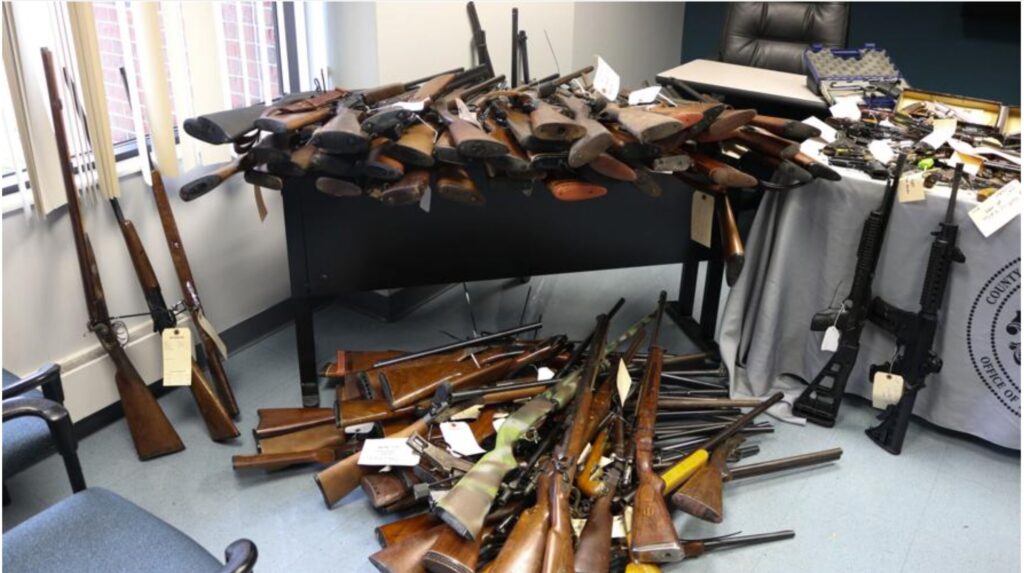
Flintlocks, black powder percussion guns, hunting shotguns, single shots, highly collectible and valuable Veteran bring-back guns from Europe, all said by DA Terry Houck to be dangerous. And yet…none of these are associated with crime. And therefore they are not dangerous.
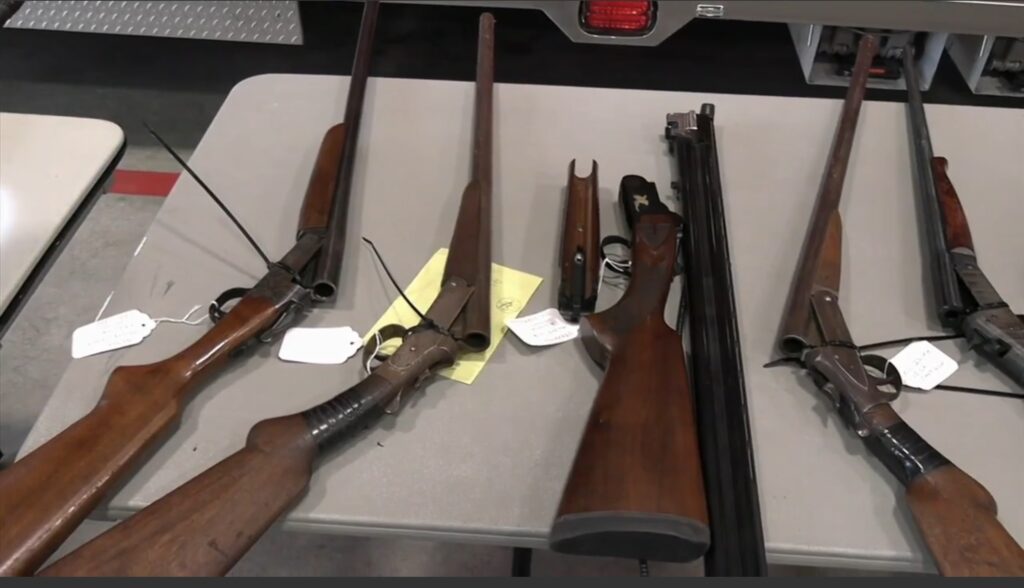
These are not the kinds of guns used in crime. Simple single shot shotguns and one really valuable over-under hunting shotgun, all destined to be destroyed. For no public benefit at all. Just to make fools feel good about themselves
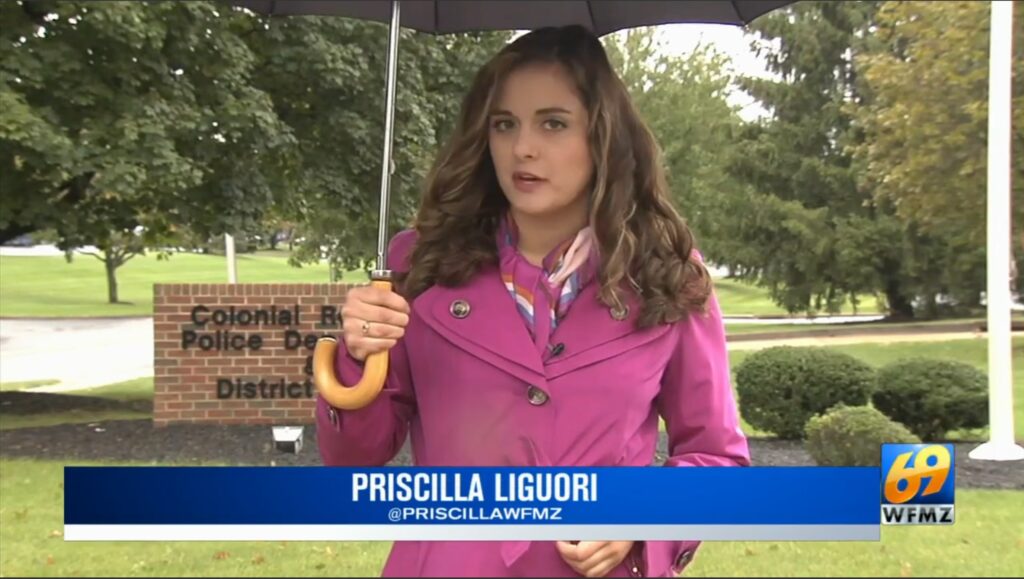
If you stand in front of a camera and talk like a parrot, are you a journalist? Priscilla Liguori asked no questions, committed no acts of journalism in the making of her report about Northampton County’s gun purchases. One more big mainstream media failure
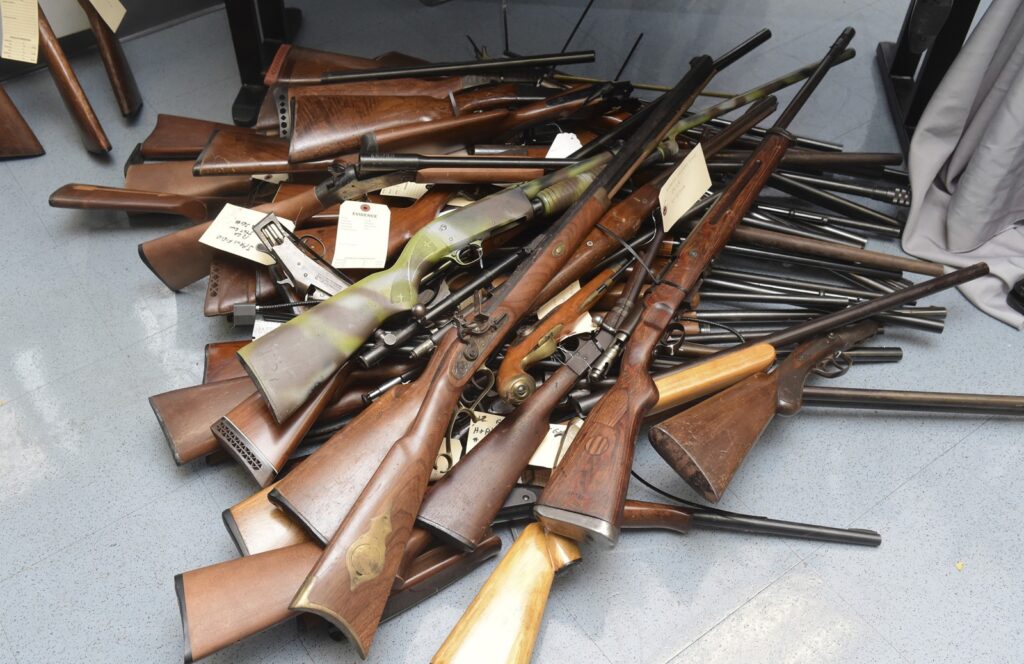
The green-colored gun is a Remington 20-gauge pump shotgun used for hunting birds and rabbits. The rifle at the far right bottom with the rounded pistol grip is a high value Veteran bring-back gun from Europe that never hurt anyone. The gun at the very top of the heap is a single shot black powder FLINTLOCK muzzleloader used to hunt deer; with 1790s technology, it has zero potential use in crime. Only hatred-filled firearm prohibitionists cheer on the destruction of these useful and safe recreational and collectible guns.
Primitive hunting techniques are more important than ever
In this day and age of popular stainless steel and plastic hunting rifles and Hubble telescope-sized rifle scopes, primitive hunting techniques and weapons are more important than ever. Something in the bad age of video games and instant gratification happened to the American character in the past thirty years or so, and so many young Americans have become lazy and even a bit heartless, as a result. Hunting culture has suffered from this, too. Really badly. Today’s focus seems to be predominantly on the kill, and much less on the process of the hunt.
Those curious about the distinction here should look up some neat videos from real hunters in the big woods of Vermont, Pennsylvania, and the Adirondacks.
Hunting should never be just about, or mostly about, killing an animal. Especially if the hunter wants to call it a trophy and put it up on his or her wall as a representation of his skill.
People trying to justify 300, 400 yard long range shots (or farther) on unsuspecting animals are not hunting, they are assassinating. Their wood craft often sucks, their field craft is limited to wearing camouflage, and their knowledge of the game animal is negligible. They are not really hunters, but rather shooters. Their high-tech guns, ammo, and rifle scopes are a crutch diminishing their need for good woodcraft, and it also results in a lack of appreciation for an actual hunt, and a lower value placed on the animal.
Culling oversized wild animal populations for the benefit of the environment is one thing, but hunting wild animals for pleasure and clean meat should be accomplished with skill. Age-old skills that everyone can respect. Hard-won wild animals taken with real skill under fair chase conditions are all trophies.
An unsuspecting big game animal assassinated at long range (or worse, inside a high fence, or over bait) requires very little hunting skill, and can never be said to be a trophy that is reflective of the hunter’s skill set. And yet isn’t this why so many hunters want big antlers and broad hides? They see these big animals as a reflection of their hunting prowess, of their manhood, their chest-thumping status within the outdoors community. As a result, America has developed a hunting culture driven by bigger-is-better trophies, at any cost, all too often achieved through long-range assassinations of unsuspecting wildlife, or over bait. Fair chase, which has always been at the heart of hunting, has been tossed away in favor of quick gratification and unfounded ego bragging rights.
The primary reason why primitive hunting weapons are so important today, is that someone has to keep the culture of hunting alive. What is a primitive hunting weapon? Pretty much any legal implement that requires the hunter to work hard to develop unique field craft/ wood craft skills, including the ability to penetrate within a fairly close range of the prey animal’s eyes, ears, and nose: Any bow (compound bow, stick bow, self bow, longbow, or other hand-held vertically limbed bow), spear, atl-atl, open-sighted black powder or centerfire rifle, any large bore handgun with or without a scope, should qualify. Flintlocks, percussion cap black powder muzzleloaders, and traditional bows are especially challenging to master and to harvest wild game with.
All of these primitive weapons require the hunter to actually hunt, to rely upon his woodcraft to carry him quietly and unseen across the landscape, and into a fair and close range of his prey animal. Animals taken with primitive weapons and techniques are earned in every way, and therefore they are fully appreciated.
Few experiences bother me more than watching some internet video of a fourteen year-old hunter running his hands over the antlers of a recently deceased buck, and listening to this inexperienced mere child discuss the finer aspects of this rack, its inches, its points, its relative size, and its (barf on my feet) trail camera name. Usually the child has shot the deer from an elevated box blind that conceals all of the hunter’s scent, sound, and movement. Whoever has taught these kids to hunt this way exclusively, and to then look at deer harvested this way as so many bragging rights, has done a huge disservice to these kids. These kids are going to grow up into poachers and baiters, always trying to prove how great of a “hunter” they are, and how studly and manly they are, at any cost. They will end up doing anything to score the next “record book” animal. These young kids who are being warped right now with this trophy nonsense are the future of America’s hunting culture, and what a crappy culture it will be if it is dominated by big egos and even bigger mouths armed with sniper rifles and no actual hunting skill.
Moms, dads, grandpas and uncles who are beginning to teach kids to hunt right now can do two simple things that will ensure their little student grows up into an ethical, responsible, high quality, law-abiding hunter: Make them use open sights on single-shot firearms and bows.
The skills that young hunters develop from having to rely on open sights and single shots (primitive weapons) will force them to achieve a high level of field craft, wood craft, and fair chase values. Developing skill requires a person to overcome challenges and adversity, often making mistakes along the way. And that results in better character.
Forcing kids to get close to their prey animal, and to take only carefully aimed shots with just open sights, will result in people who become really excellent hunters. Adults can always opt to add a scope to their rifle as their eyes age, but the lessons learned early on in concealment, controlling movement, playing wind direction, and instinctive shooting will keep the respectable art of hunting alive and well.
This Fall, get your little one started on a flintlock or old Fred Bear recurve bow from the get-go, for squirrels and deer, and watch as a true hunter is born.
What is hunting?
With hunting seasons drawing to a close here in Pennsylvania, it is worth the time to revisit an old question, which is What is hunting?
We ask because, without question, non-hunters overwhelmingly support hunting that is fair chase and purposeful. That is, hunters who are seen by the public to be respectful of our prey are recognized as a positive force, and worthy of continuing their pastime.
Every scientific opinion survey asking Americans their opinion about this subject for the past several decades has yielded the same result: Hunters who actually hunt get respect and support from non-hunters. On the other hand, people who are perceived by the general public to be casually killing animals just for pleasure or for “trophies” usually do not garner much support.
While there is a lot for us to talk about with even just the survey question itself, like how America has become so urbanized and thus our people so distant from the natural resources and processes that feed and clothe us and wipe our butts (toilet paper from trees harvested in forests) etc, this particular question, and its answer, is most important because hunters are a minority of a minority in America.
Positive public opinion about hunters and hunting is necessary to the continuation of regulated hunting as we know it and as it has been practiced for the past 100 years.
Given that American hunters are lamentably awash in a sea of soulless plastic and stainless steel rifles these days, whereupon the Hubble Telescope-equivalent scope is mounted, many owners of these contraptions are regularly and quite naturally tempted to attempt military-grade long distance sniper assassinations of far-off big game animals.
Though fleet of foot, strong of heart, and equipped with majestically sensitive noses, ears, and eyes, these animals cannot compete with humans who are so far removed from the natural zone of awareness these animals’ senses otherwise provide them. This begs the question of whether or not long-long-distance shots at these clueless animals are actual fair chase hunting, or are they incautious and disrespectful maltreatment of animals we otherwise admire.
Honestly, this stark question brings to my mind the images of charismatic megafauna hand-painted on cave walls by our spear-wielding ancestors: Rhinos, gigantic cave bears, massive aurochs, lions, zebras and wild horses, bison, etc. dangerous animals all, taken at great personal risk and at bad breath distance, contrasted with today’s ego-driven high-fence “trophies” mounted on manicured man cave walls around America, animals snuffed out without a chance at fight or flight. The cave paintings were the Sistine Chapel experience for paleolithic humans, and today’s manicured egocentric faux trophy rooms are very sorry substitutes. Authentic versus fake, they couldn’t be more different from one another.
So, a bear or deer taken with a bow, a crossbow, a spear, an atlatl, a blowgun, a shotgun, a flintlock or percussion muzzleloader, or a modern muzzleloader or rifle with open sights seems like a pretty natural example of fair chase. The 400-yard Hubble Telescope plus “500 Magnum Killem” caliber assassination of the unknowing and unsuspecting beast is just that, an assassination. Is there anything fair or chase about it?
Just as political America now requires a return to our simple and beautiful founding principles, so will our hunters benefit from returning to mastering the basics of early American woodcraft, the ability to sneakily slither and glide into the wind across a landscape to get within the animal’s sensory zone and make an honest and competitive kill. This kind of field craft is the essence of fair chase.
Artificial reliance by hunters on high tech is embarrassing, to tell you the truth of how I feel. Repent and return to the basics, brothers and sisters! Our fellow Americans who do not hunt will not only support us, they will admire us, and as a result of their admiration our outdoor lifestyle will have a much greater chance of surviving beyond the high tech culture that is otherwise crushing everything natural and alive in its unwholesome path.
